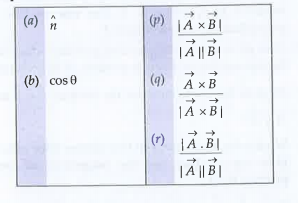If θ is smaller angle between force vector →F and velocity vector →v then Fv cos θ represents
work
power
kinetic energy
centripetal force
The correct Answer is:B
To solve the question, we need to analyze the expression Fvcosθ where θ is the angle between the force vector →F and the velocity vector →v.
1. Understanding the Expression:
- The expression Fvcosθ involves the force F, the velocity v, and the cosine of the angle θ between the force and velocity vectors.
2. Considering Small Angle:
- Since θ is described as a smaller angle, we can use the approximation that cosθ≈1 when θ approaches 0.
3. Substituting the Approximation:
- Therefore, we can simplify the expression:
Fvcosθ≈Fv⋅1=Fv
4. Identifying the Physical Quantity:
- The term Fv can be related to power. Power (P) is defined as the rate at which work is done, and it can be expressed as:
P=Wt
- Work (W) done by a force is given by:
W=F⋅d
where d is the displacement in the direction of the force.
5. Relating Power to Force and Velocity:
- If we consider the displacement d over a time interval t, we can express velocity as:
v=dt⇒d=vt
- Substituting this into the work formula gives:
W=F⋅vt
- Therefore, the power can be expressed as:
P=F⋅vtt=Fv
6. Conclusion:
- Thus, we conclude that Fvcosθ represents power when θ is a small angle.
Final Answer:
The term Fvcosθ represents power.
- The expression Fvcosθ involves the force F, the velocity v, and the cosine of the angle θ between the force and velocity vectors.
- Since θ is described as a smaller angle, we can use the approximation that cosθ≈1 when θ approaches 0.
- Therefore, we can simplify the expression:
Fvcosθ≈Fv⋅1=Fv
- The term Fv can be related to power. Power (P) is defined as the rate at which work is done, and it can be expressed as:
P=Wt
- Work (W) done by a force is given by:
W=F⋅d
where d is the displacement in the direction of the force.
- If we consider the displacement d over a time interval t, we can express velocity as:
v=dt⇒d=vt
- Substituting this into the work formula gives:
W=F⋅vt
- Therefore, the power can be expressed as:
P=F⋅vtt=Fv
- Thus, we conclude that Fvcosθ represents power when θ is a small angle.
The term Fvcosθ represents power.
Topper's Solved these Questions
Similar Questions
Knowledge Check
- Question 1 - Select One
If θ be the angle between two vectors →a and →b, then →a.→b≥0 only when
A0<θ<π2B0≤θ≤π2C0<θ<πD0≤θ≤π - Question 2 - Select One
The angle between the vectors →Aand→B is θ. The value of →A(→A×→B) is -
AA2BBzeroCA2BsinθDA2Bcosθ - Question 3 - Select One
If →a.→b=∣∣→a×→b∣∣, then angle between vector →a and vector →b is :
Aπ2Bπ6Cπ4Dπ3
If angle between two unit vectors →a and →b is θ then sin(θ2) is equal to
View SolutionLet θ be the angle between two vectors →A and →B and ˆn is a unit vector perpendicular to their plane.
 View Solution
View SolutionIf θ is the angle between any two vectors →a and →b, then ∣∣→a.→b∣∣=∣∣→a×→b∣∣ when θ is equal to(A) 0 (B) π4 (C) π2 (D) π
View SolutionIf →m,→n,→r are three vectors, θ is the angle between the vectors →mand→n, what is mnr cos θ equal to ?
View SolutionIf the angle between the vectors →a and →b is an acute angle, then the diffrence →a−→b is
View Solution

